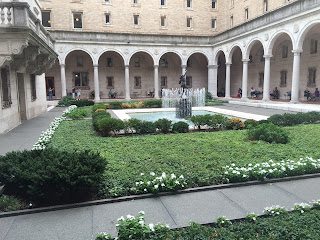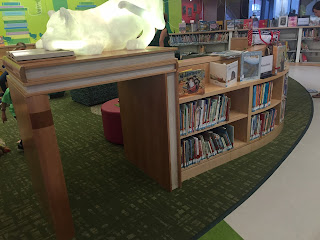
What does a librarian do on vacation? Well, this one visits libraries. Before you think I am a total nerd, that's not ALL I do. But on a recent trip to New England, I found myself in Boston. One stop on the trip included the amazing Boston Public Library. I really wanted to see the newly refurbished Children's area. We are in the process of four (
yes, four!) library projects, and so I wanted to get inspiration from the fabulous jewel of a library.
I entered through the front, and was led into an open courtyard. This was a PUBLIC library, not a mansion or a museum. Anyone can come in here. Anyone who wants can experience this lovely space. It was built as a "
palace for the people". What a gift to Boston. Yes, I was amazed. But I had to head upstairs to the Children's area.

I was suitably impressed. The small shelf, with a space for kids to crawl under, was being used exactly for that. I saw a young boy happily crawling under several times. You know that child is going to have happy memories of this library. See that lion on top of the shelf? It has changing LED lights inside. I saw another child standing next to the lion, naming the colours as they changed. How's that for early learning?

The colours in this library are so bright! You'd never know you were in an building from 1895. It feels fresh, modern, and has the child in mind in every way. There's a huge chair for story-sharing, and I saw a grandmother and her two grandkids doing just that-- sitting together reading. There's comfy seating everywhere, and even some that kids can move around and use where they want. The whole place was abuzz with kids and their adults, enjoying books and play, and fun!
There's an interactive wall, with built-in playscapes and this cool light feature. Adults like the play area as much as the kids do, and here's proof.
After soaking in the features of this room, I headed over to the Teen space. Since
Margaret Atwood is helping us raise funds for the Kentville teen area, I thought I should get some ideas. The first thing I noticed was the room full of teens hanging out. They were playing games, sitting at a table working on a project, reading, and just hanging out. All libraries need this kind of space, where teens are welcome and know it.
Look at that retro READ sign. And the shelves are really nice, with a city-scape feel, appropriate in a downtown library. I was really impressed with this seating area, with decoration made from old card catalog boxes. Beyond you can see some of the adult fiction area, with the vibrant red colour scheme.
I didn't even see the rest of the library, as I was due to make an appearance at a
graveyard. But that's another story for another day. Let's just say I was impressed, and I can't wait for our libraries to impress you. If you want to help make all our library dreams come true, just visit our "
Support our New Library Projects" page!
--Angela J. Reynolds, Community Engagement Coordinator
 Seniors Week is a provincial initiative to incorporate library promotion and engagement of seniors within our communities. Public libraries are encouraged to engage with our seniors and work together to provide for their needs. National Seniors Day will be celebrated on October 1, 2016. Provincially, Seniors Week will be celebrated from October 1 - October 7, 2016.
Seniors Week is a provincial initiative to incorporate library promotion and engagement of seniors within our communities. Public libraries are encouraged to engage with our seniors and work together to provide for their needs. National Seniors Day will be celebrated on October 1, 2016. Provincially, Seniors Week will be celebrated from October 1 - October 7, 2016.